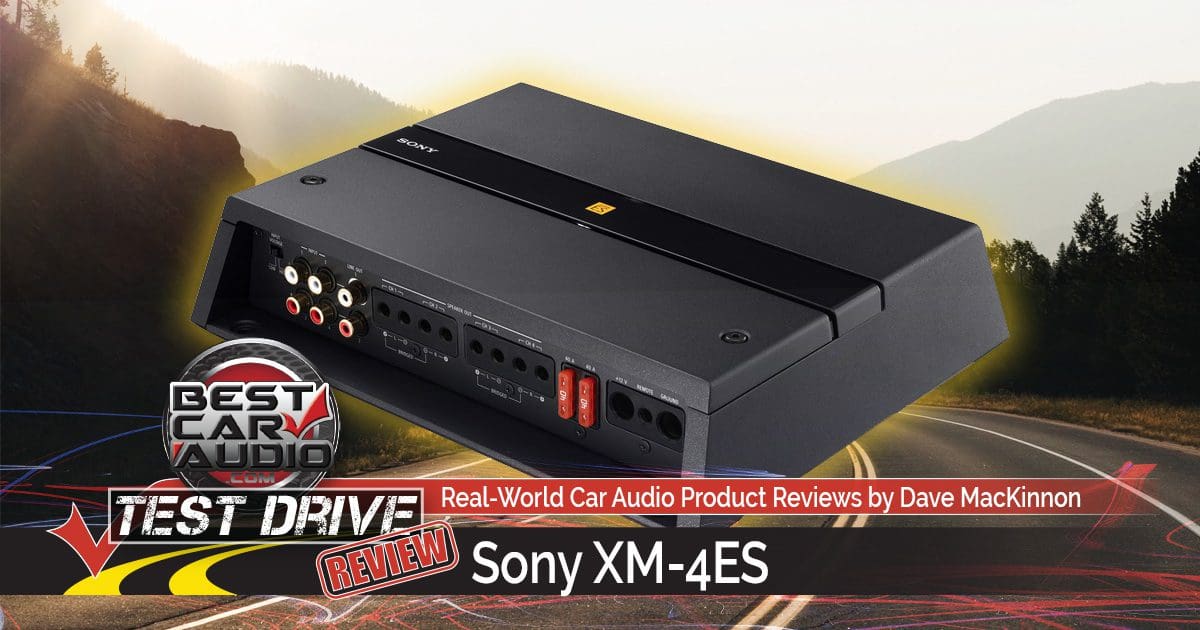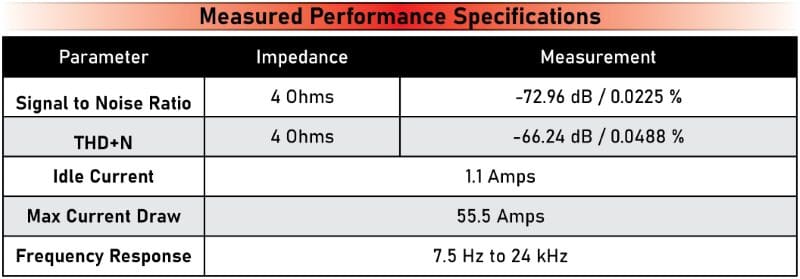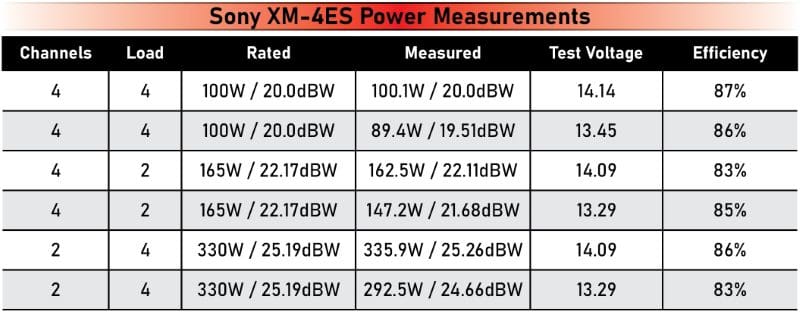If it seems as though you’re seeing several Sony Mobile ES products crossing the BestCarAudio.com Test Drive Review bench, you aren’t mistaken. The Sony team is justifiably proud of what they have created, and we’re honored to get the chance to check out the fruits of their labor. We’ve reviewed their flagship source unit, subwoofers and monoblock amp, and now it’s time for a full-range amplifier. The four-channel XM-4ES amplifier is the subject of this review. Let’s see what they’ve come up with!
Sony XM-4ES Amplifier Design and Features
Based on the same cast-aluminum heatsink as the XM-1ES, the four-channel XM4-ES measures 10.75 by 8.75 inches in footprint and stands 2.365 inches tall. All the power, speaker and signal connections are made along the front edge of the amp, as you’d find in any premium product. Sony has included a removable aluminum cover to conceal the setting and control switches on top of the amp, so it looks tidy once installed. The plastic trim piece in the center of the top panel can be rotated 180 degrees to align with the installed orientation in your vehicle.
Sony proudly mentions that they paid close attention to the bottom panel of the amp during the design process. Rather than a piece of plastic or flimsy metal, the bottom cover is stamped aluminum that’s over a millimeter thick and has been reinforced with ribs to keep everything rock solid. The last thing you want to hear in a component you’ve chosen for an upgrade to your vehicle is rattling and buzzing as you drive.
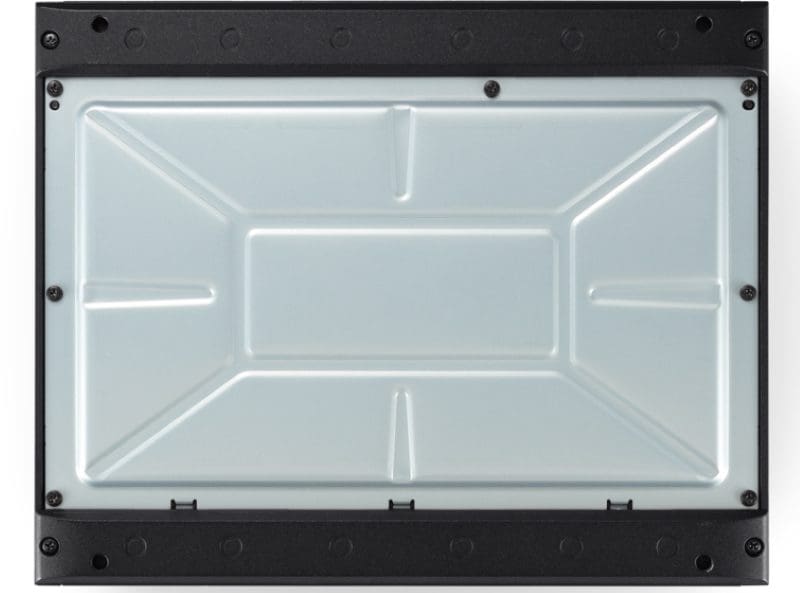
In terms of connections, Sony tooled custom terminal blocks for the power and speaker connections to make them compatible with bare wires and when wire ferrules are used. The power connections will accept 0-AWG cables, and the speaker connections will take 8-AWG. The amplifier includes a set of line-out jacks if your installer wants to connect it to a subwoofer amp like the XM-1ES. And with a pair of 40-amp ATC fuses on the chassis, you won’t need to purchase an extra fuse holder to be installed beside the amplifier.
In terms of specifications, the XM-4ES is rated to produce 100 watts of power per channel when driving 4-ohm loads and 165 watts with 2-ohm speakers. Each pair of channels can be bridged to drive a single 4-ohm load with up to 330 watts of power if you want it to run a subwoofer or something like a tower speaker in a marine application, assuming the amplifier is protected from the elements.

Signal Processing and Integration Features
Sony went all-out in equipping this amp with features to make integration with a factory-installed source unit easy. The four-position Input Mode switch allows the four RCA jacks to feed the four outputs discretely or one input to feed all four outputs. There’s also a bridged mode where input 1 feeds outputs 1 and 2, and input 2 feeds outputs 3 and 4. Finally, and most uniquely, there’s a mode labeled 1+3/2+4 that combines the signals on inputs 1 and 3 and sends that combination to both outputs 1 and 3, and the same for 2 and 4. If your factory audio system has electronically filtered woofers and tweeters in the front, this mode can be used to recombine those audio signals. The Turn-On switch activates the signal detection turn-on feature, and another selects the audio source for the output RCA jacks.
Each pair of channels has a stereo sensitivity control with a range of voltages from 0.2 to 8. A switch on the front panel near the RCA jacks increases the voltage range to 3 to 16 volts. The amp has differential inputs, so the speaker wires from your factory radio can be connected directly to the amp without needing an adapter. Of course, if you’re a regular reader of BestCarAudio.com, you’ll know that the expectation is that a good quality amplifier will have differential inputs to prevent noise picked up by the interconnects from passing through to the speakers. As such, twisted-pair RCA cables are recommended.
In terms of filtering, each pair of channels has adjustable high- and low-pass filters along with the range adjustment switch. The -12 dB/octave filters can be set anywhere from 50 to 500 hertz in their low range. In the high range, the filter is 500 to 5 kHz. The filter mode switch allows your installer to select between Off, high-pass, low-pass or band-pass modes.
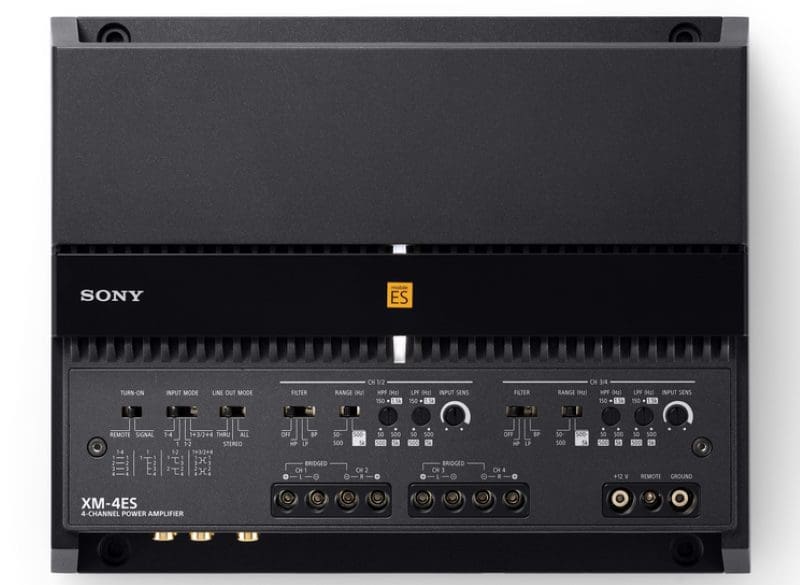
Looking inside the amp, I found a modern circuit board design that uses surface-mount components for everything except the power supply capacitors, the transformer, chokes, switches and potentiometers. Speaking of switches and potentiometers, these devices are on a daughterboard mounted vertically in the amp and secured with a stamped steel frame. The metal frame frees the pin headers at the base of the board from bearing the load of vibrations, bumps and rattles. I should note that the audio output filter chokes are enclosed in ferrite housings to reduce the radiation of high-frequency energy from the Class D switching outputs.
In terms of capacitance, the amp has a bank of six 2,200-microfarad, 16-volt caps on the inputs and 12 800-microfarad, 50-volt caps on the power supply output. A pair of chokes on the inputs helps prevent switching noise from feeding back out of the amp through the power cables. The power supply uses six surface-mount Toshiba MOSFETS, each rated for up to 90 amps of current. Each output channel has a pair of 11-amp MOSFETS as output switching devices. That’s enough current capacity for almost 500 watts of power per channel. Each output pair is driven by an Infineon high-voltage, high-performance Class D driver IC. The board layouts are tidy, and everything is attached securely to the aluminum chassis.
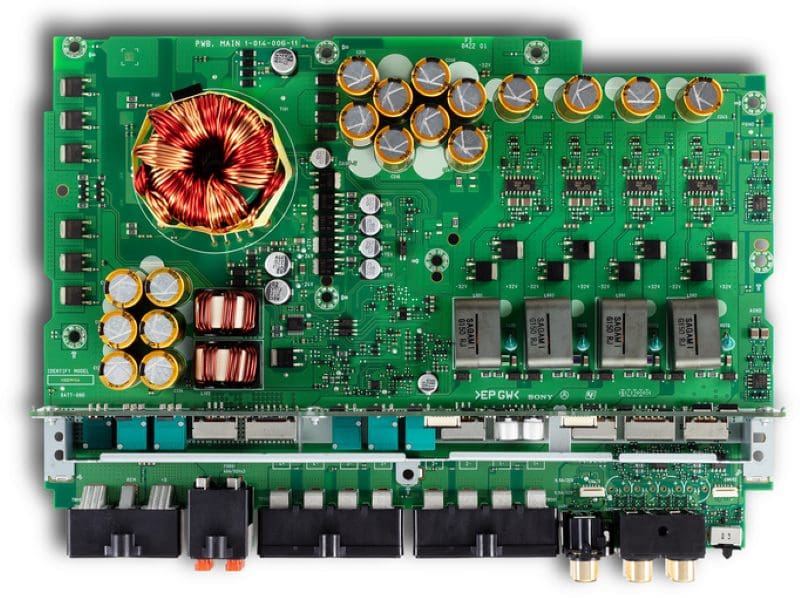
Auditioning the Sony XM-4ES
More than satisfied with the features and design of the XM-4ES, I brought the amp to my listening room to check it out. I have a pair of nice home-audio bookshelf speakers connected to channels 1 and 2, and I used the 10-inch Sony XM-W104ES in the fancy enclosure I built for its Test Drive Review last year. The sub is powered by channels 3 and 4 in a bridged configuration. My heavily modified DRZ-9255 would serve as the audio source, and as always, I set the relative level of the subwoofer channel to the mains using an RTA and my target curve.
The first track I listened to was “You Should See Me in a Crown” by Billie Eilish. I find that her breathy, whispery voice doesn’t come through clearly in the car unless the volume is moderately high. In my reference system, the balance was perfect. Every word was clear and detailed. Billie loves her bass, and the output of the 10-inch Mobile ES sub powered by the XM-4ES didn’t disappoint. There was good control and impressive low-frequency extension. The amp sounded great at all volume levels, including being able to rattle the ceiling tiles. I must add some weight to those to tame them!
Next, I cued up “Everywhere” by Fleetwood Mac. Stevie Nicks’ voice was locked in the center of the soundstage and was buttery smooth. Listening to female vocals is a great way to detect harshness in a speaker system or amplifier design. The Sony behaved perfectly and sounded great.
I listened to “Grenade” by Bruno Mars next. This track’s bass line flows into the midbass and midrange region, so getting the crossover between the sub and the bookshelf speakers right is essential. Amplified by the XM-4ES, the track sounded great, and everything was tight and coherent.
Lastly, I listened to “Everlasting Light” by the Black Keys. This track presented a massive wall of sound from the end of the room. The percussion was tight and well-controlled. The deliberately distorted vocals from Dan Auerbach were clear without any harshness or unwanted emphasis. I predict this amp will perform well on the bench in terms of distortion.
Frankly, it only takes a few seconds of listening to a song I’m very familiar with to decide whether an amp has been well-engineered. Sitting and listening to music for an hour in the middle of the day is just one of those bonuses that comes with the job of professionally reviewing car audio products. Two thumbs up to Sony for their design on the XM-4ES – it sounds absolutely great!
Lab Testing the Four-Channel XM-4ES
I started the lab testing by measuring the amp’s frequency response into 4- and 2-ohm resistive loads and my simulated reactive load.
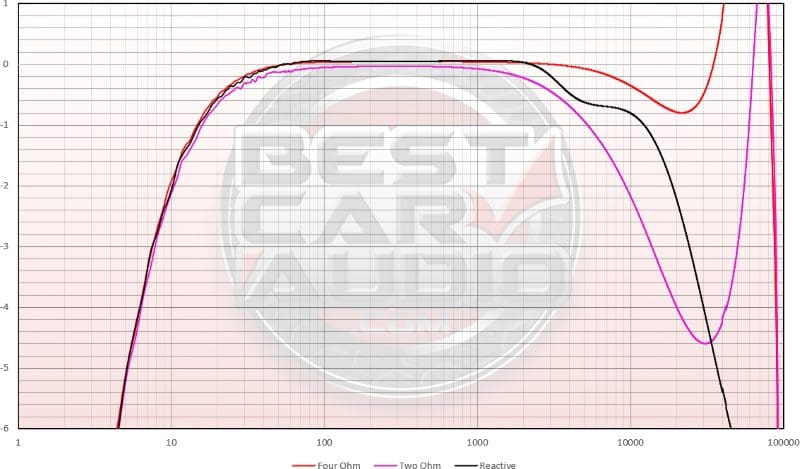
Not surprisingly, the amp was happiest when driving a reactive load and offered smooth high-frequency extension without any resonance from the output filter. With all the processing turned off, using the reactive tests, the XM-4ES was -3 dB at 7.5 hertz on the bottom and 24 kHz on the top.
Next, I tested the response of the crossovers. I eyeballed the measurements labeled “mid” in the graph below to be in the center of the adjustment range. I was pleased to see things lined up well with the target filter frequencies. There is a bit of output attenuation associated with the extreme ends of the filter frequencies, so ensure that your installer sets the crossovers before finalizing the sensitivity control adjustments.
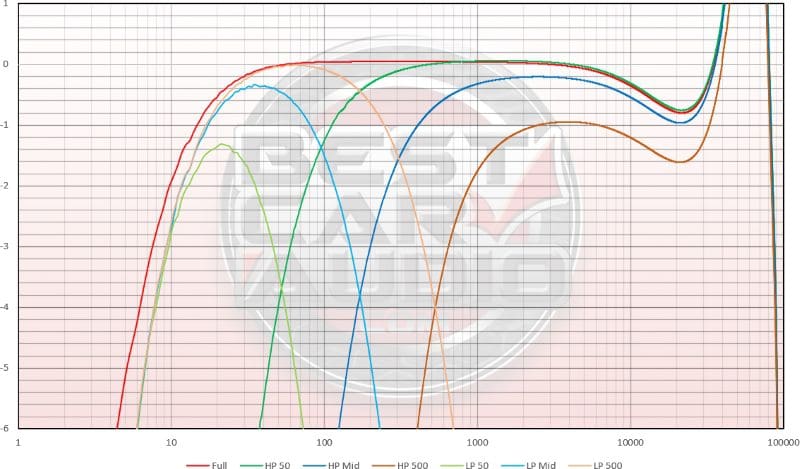
Second to last, I checked the distortion and noise characteristics of the amp with a 1-kHz test tone set to 2.0 volts. This output level is the 1-watt reference outlined in the ANSI/CTA-2006-C standard. Total harmonic distortion was better than the 0.05% spec at 0.0488%. The signal-to-noise ratio was measured at -72.96 dB. Both numbers are rock-solid for a modern Class D car audio amplifier.
Last and certainly not least, it was time to check out the power production capabilities of the amp. Consumers put too much emphasis on these numbers, especially when qualifying amplifier quality. Nevertheless, the XM-4ES had no problem dishing out power in line with the 100-, 165- and 330-watt 14.4-volt specifications. The 2-ohm power was just a hair below the 165-watt rating, but the supply voltage was 3/10ths below the 14.4V spec, so it all makes sense. Sony’s numbers are accurate and believable.
Conclusions on the Sony XM-4ES Four-Channel Car Audio Amplifier
It’s a genuine joy to test a product and have it perform exactly as the manufacturer claims. When other companies focus on reducing costs and increasing profits, it’s nice to see brands like Sony and their Mobile ES line striving to give consumers well-designed solutions that deliver impressive sound quality. As soon as I fired up the XM-4ES in my listening room, I knew it was a home run, and the bench testing confirmed this.
If you’re shopping for a high-quality amplifier that’s well-equipped with signal processing and vehicle integration features, visit a local authorized Sony Mobile ES retailer and ask to check out the XM-4ES four-channel amplifier. Follow Sony Car Audio USA on Facebook to learn about their latest product releases.
